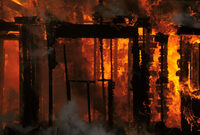 Among the top fears when it comes to keeping you and your family safe at home is the possibility of an outbreak of fire. Although rare and on the most part being able to be avoided, when fire does strike, it is a menacing sight and leaves thousands of people each year heartbroken, injured or even worse.
Among the top fears when it comes to keeping you and your family safe at home is the possibility of an outbreak of fire. Although rare and on the most part being able to be avoided, when fire does strike, it is a menacing sight and leaves thousands of people each year heartbroken, injured or even worse. Probably the most common type of fire domestically is one that involves electrical equipment. Inadequate electric wiring, loose and frayed plugs and overloaded sockets contribute to a huge percentage of house fires.
Knowing how to minimise risk factors involved with electrical fires can go a long way in avoiding fires. Not many homes are equipped with a fire extinguisher in the event of fire, particularly an extinguisher capable of dealing with electricity based blazes.
Imitation Chargers:
Although imitation electrical chargers for devices such as mobile phones may be up to 99% cheaper than their genuine counterparts, they could end up costing you a lot more in the long run. Some imitation chargers may be unsafe and an instant fire hazard the moment they are used.
Electrical Maintenance:
Keeping appliances clean and working is not just a show for presentation or usefulness. This maintenance can also reduce the risks of electrical fire greatly.
Unplugging Devices:
A common sight in many homes is a plugs in sockets and switched on when not in use. There is a constant electrical charge making its way from the source which increases the chances of fire as well as wears the plug and socket out over time. This idea is particularly useful when it comes to hair straighteners.
They can get very hot and should always be left to cool on an appropriate heatproof surface after being switched off.
Phone chargers should not be left on overnight. It doesn't generally take 8 or even more hours to fully recharge a mobile phone. The risk of overheating is greatly increased and your phone and charger are being put under unnecessary stress from the excessive amounts of electrical energy being pumped through them.
Use the Correct Plug:
Sometimes appliances are sold without a plug or a plug needs replacing. It may be tempting to find a plug somewhere in the home that will fit. Be careful and ensure that the plug being used is of the correct fuse and power as the wrong type will increase the risk of fire.
One Plug per Socket:
Plug sockets are designed to accommodate only one plug at a time. Where possible, adaptors which increase the numbers of plugs that can be used should be avoided. If they must be used, seek an ‘in-line’ adaptor. These adaptors are restricted in how much power they can provide and can reduce electrical fire risk.
Electric Blankets:
Electric blankets should be stored flat and rolled up or folded loosely. Blankets should always be unplugged before going to sleep and avoided entirely if you have an airflow mattress. Stay clear of electric blankets if you have been prescribed any paraffin based emollient creams – speak to your doctor about alternatives if you really want to use an electric blanket.
Following these steps will not eradicate the danger of electrical fire completely but will make your home and your family with a much better chance of avoiding potential danger. Remember, overloading power sockets, extension leads and untested appliances can all lead to peril. Be sure to regularly check for fire hazards and do whatever you can to nullify any potential threats you find.
Fires should be left to fire fighters to deal with although sometimes people feel they can put them out themselves. Only do this if it is positively safe to do so. Water based fire extinguishers are not appropriate for tackling electrical fires and should be avoided. If you are to fight an electrical fire at home make sure you use a fire extinguisher that is suitable such as carbon dioxide and dry powder fire extinguishers.